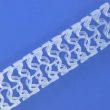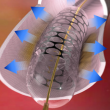A center carrying out a mid- to long-term follow-up of the performance of everolimus-eluting bioresorbable scaffolds (Absorb) observed that this new device has an acceptable rate of major cardiovascular events, when compared to second-generation drug-eluting stents. Furthermore, although the population was complex and non-selected, no cases of early thrombosis were reported. This study enrolled 249 patients<a href="https://solaci.org/en/2016/08/03/bvs-comparable-to-second-generation-des-in-complex-lesions/" title="Read more" >...</a>
STEMI: Best P2Y12 inhibitor according to network meta-analysis
Original Title: Optimal P2Y12 inhibitor in patients with ST-segment elevation myocardial infarction undergoing primary percutaneous coronary intervention: a network meta-analysis. Reference: Rafique AM et al. J Am Coll Cardiol Intv 2016;9:1036–46. Courtesy of Dr. Alejandro Lakowsky. Researchers drew up a network meta-analysis incorporating 37 trials with more than 88,000 patients undergoing ST elevation<a href="https://solaci.org/en/2016/06/22/stemi-best-p2y12-inhibitor-according-to-network-meta-analysis/" title="Read more" >...</a>
Immediate vs. Delayed Stenting in Primary PCI
Original Title: Comparison of Immediate With Delayed Stenting Using the Minimalist Immediate Mechanical Intervention Approach in Acute ST-Segment–Elevation Myocardial Infarction. The MIMI Study. Reference: Loic Belle et al. Circ Cardiovasc Interv. 2016 Mar;9(3). Delayed stenting after normal epicardial flow restoration is meant to lower the chance of distal embolization and to improve reperfusion in the<a href="https://solaci.org/en/2016/03/30/immediate-vs-delayed-stenting-in-primary-pci/" title="Read more" >...</a>
Meta-Analysis of Bioresorbable Vascular Scaffolds vs. Everolimus Eluting Stents
Courtesy of Dr. Agustín Vecchia. The aim of this study was to compare the safety and efficacy of bioresorbable everolimus eluting scaffolds (BVS) vs. everolimus eluting stents (EES) in patients with ischemic heart disease. Medline, Embase, the Cochrane Central Register of Controlled Trials (CENTRAL), was searched for scientific sessions, abstracts, and relevant websites for<a href="https://solaci.org/en/2016/01/19/meta-analysis-of-bioresorbable-vascular-scaffolds-vs-everolimus-eluting-stents/" title="Read more" >...</a>
IMPROVE-IT: The combination simvastatin / ezetimibe reduces post SCA events
This work included 18144 patients from 39 countries that were admitted pursuing an acute coronary syndrome (with or without ST segment elevation) randomized 1: 1 to receive the combination of simvastatin 40 mg / ezetimibe 10 mg (n = 9067) or simvastatin 40 mg alone (n = 9077). Of the total, 88% received a coronary<a href="https://solaci.org/en/2015/06/24/improve-it-the-combination-simvastatin-ezetimibe-reduces-post-sca-events/" title="Read more" >...</a>
Mitral valve repair in moderate ischemic mitral regurgitation
Article Up to 50% of acute myocardial infarctions are associated to mitral regurgitation of some degree and 10% of these cases present, at least, moderate regurgitation. Ischemic mitral regurgitation is associated to an increase of mortality and morbidity. For surgical patients with moderate regurgitation, the benefits mitral valve repair remain unclear. 301 patients were randomized<a href="https://solaci.org/en/2015/06/24/mitral-valve-repair-in-moderate-ischemic-mitral-regurgitation/" title="Read more" >...</a>
MITOCARE: TRO40303 intravenous infusion in the context of primary angioplasty
Prospective, multicenter, randomized, double-blind study evaluated intravenous infusion of TRO40303 versus placebo administered immediately before balloon dilation of the culprit artery during primary angioplasty. Infarct size was evaluated using the CK Mb levels and troponin together with magnetic resonance imaging. 163 patients were included; no significant differences were observed in the area under the curve<a href="https://solaci.org/en/2015/06/24/mitocare-tro40303-intravenous-infusion-in-the-context-of-primary-angioplasty/" title="Read more" >...</a>
SIGNIFY: Ivabradine does not reduce events in patients with stable coronary disease
The increase in heart rate in the setting of chronic coronary artery disease is associated with poor prognosis, especially increased risk of acute myocardial infarction. Reducing heart rate with ibravadina inhibitor may confer symptomatic benefit of angina and reduce coronary events in patients with chronic coronary disease and a resting heart rate ≥ 70 bpm.<a href="https://solaci.org/en/2015/06/24/signify-ivabradine-does-not-reduce-events-in-patients-with-stable-coronary-disease/" title="Read more" >...</a>
VELOCITY: Peritoneal hypothermia in patients undergoing primary angioplasty
There are clinics hypothesis that systemic hypothermia (≤34.9) could reduce infarct size if set before reperfusion. Peritoneal lavage had a well-established safety profile and given the large surface area of the bowel may cause rapid hypothermia reducing infarct size. The aim of this study was to evaluate the safety and efficacy of hypothermia induced by<a href="https://solaci.org/en/2015/06/24/velocity-peritoneal-hypothermia-in-patients-undergoing-primary-angioplasty/" title="Read more" >...</a>
OCT-STEMI: Primary angioplasty guided by OCT
This study included 201 patients suffering ST-segment elevation acute coronary syndrome and randomized to the use of optical coherence tomography (OCT) versus conventional angiography for the procedure. OCT-guided group used more stents per patient (1.4 versus 1.2, p = 0.03) and greater release pressure. During control OCT suboptimal results were found in a third of<a href="https://solaci.org/en/2015/06/24/oct-stemi-primary-angioplasty-guided-by-oct/" title="Read more" >...</a>








